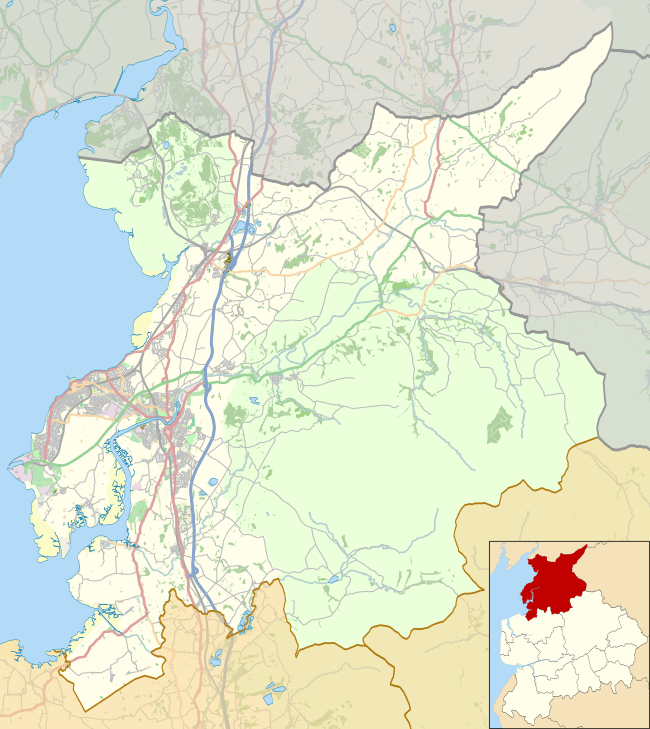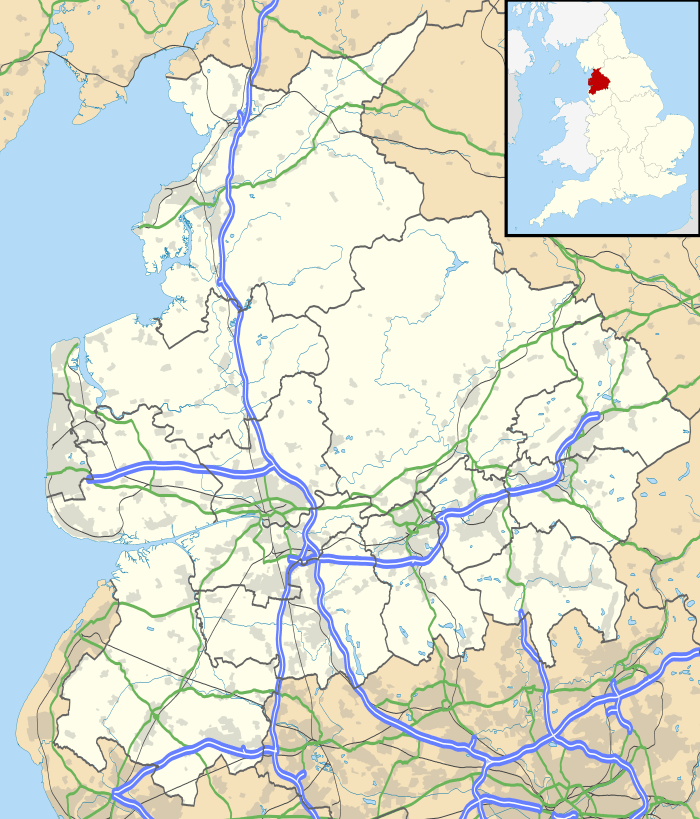Glasson Dock
| Glasson Dock | |
|---|---|
 The lock at Glasson Dock | |
 Glasson Dock Location in the City of Lancaster district  Glasson Dock Glasson Dock shown within Lancashire | |
| OS grid reference | SD443561 |
| Civil parish | |
| District | |
| Shire county | |
| Region | |
| Country | England |
| Sovereign state | United Kingdom |
| Post town | LANCASTER |
| Postcode district | LA2 |
| Dialling code | 01524 |
| Police | Lancashire |
| Fire | Lancashire |
| Ambulance | North West |
| EU Parliament | North West England |
| UK Parliament | |
Glasson Dock, also known as Glasson, is a village in Lancashire, England, south of Lancaster at the mouth of the River Lune. In 2011, it had a population of around 600.
History
Before becoming a dock, Glasson was the site of small farming and fishing community, known as Old Glasson and Brows-saltcote. Directly across the river from Glasson lies the village of Overton.[1]
Due to the difficulty of navigation up the Lune to the docks in Lancaster, the Lancaster port commission decided to build a dock at Glasson in 1779. They purchased land in 1780,[1] and by 1782, a pier had been constructed, but there were problems and the west wall began to bulge. In August 1782, the commissioners asked Henry Berry, who was employed as the engineer for the Liverpool docks, to arbitrate in the dispute with the contractor, and to design a dock, to be located by the pier. Berry was unable to do so, as he was so busy, and so the engineer Thomas Morris was asked instead. He produced plans in November 1783, for a project which involved rebuilding the bulging wall, and the construction of another short pier from the opposite bank of the river, so that gates could be fitted between the two. The estimated cost was £2,700, and Mr. Fisher was appointed as the new contractor, with Morris acting as engineer for a salary of £100 per year. Construction was finished by March 1787, when the dock opened, with Morris remaining as engineer until December.[2] The dock was well equipped and could hold up to 25 merchant ships.[3]
With construction of the Lancaster Canal starting in 1792, thought was given to a connection between it and the sea, and John Rennie's plans for a Glasson branch formed the basis for an Act of Parliament which was obtained in May 1793. No work took place,[4] and it was not until 1819 that the plans were revived, when another Act of Parliament was needed to raise additional finance. The estimated cost of the branch was £34,608, and work began in 1823. The 2.5-mile (4.0 km) branch dropped through 52 feet (16 m) from Galgate, and the basic engineering was completed in December 1825, but financial difficulties meant that warehousing and wharves could not be constructed at first, and so the build-up of trade was slow. However, by 1830 over 10,000 tons of goods passed through the dock, most of it passing on to the canal. Because the locks were 14 feet (4.3 m) wide, smaller ships did not have to tranship their cargoes to canal boats, as they could sail through the dock and along the canal. The first such boat to do so was a schooner called Sprightly, which carried slate to Preston in May 1826. Incoming trade included slate, timber, potatoes and grain, while coal was exported through the port to Ulverston, North Wales and Ireland.[5]
As the ships using the dock did not require significant amounts of local labour, the settlement around the dock did not grow significantly. Many of the buildings in the village were built in the 19th century, including Christ Church, which was built in 1840, although expanded in 1931–32. A shipyard and Customs House were built in 1834, a Watch House in 1836, and a Dry Dock in 1841. The shipyards were largely concerned with ship repair rather than shipbuilding, eventually closing in 1968, with the dry dock filled in a year later.[1]
The quay was connected to the railway network in 1883, operating until the closure of passenger services on 5 July 1930. Goods rail traffic continued until 7 September 1964. The trackbed of the disused branchline is now a linear park and cycleway.[1]
A limited amount of commercial traffic still uses the dock, with outbound shipments including coal for the Isle of Man and the Western Isles of Scotland, and incoming cargoes including animal foodstuffs and fertilizer, which are stored in the sheds located on the dock side.[1]
Glasson dock postcode (LA2 0) came up as the winning postcode in the postcode lottery back in November 2017 where each winning ticket scooped a share of 3 million pounds. Winners won £12,800 per ticket and had up to three tickets. The winning postcode was, LA2 0DJ and there was one lucky winner who won a cool £273,460.[6] In the same week, neighbouring village, Galgate was hit with a flash flood and the postcode lottery donated a generous £15,000 to help the locals with their tragedy.
Entering the dock
Glasson Dock | |||||||||||||||||||||||||||||||||||||||||||||||||||||||||||||||||||||||||||||||||||||||||||||||||||||||||||||||||||||||||||||||||||||||||||||||||||||||||||||
|---|---|---|---|---|---|---|---|---|---|---|---|---|---|---|---|---|---|---|---|---|---|---|---|---|---|---|---|---|---|---|---|---|---|---|---|---|---|---|---|---|---|---|---|---|---|---|---|---|---|---|---|---|---|---|---|---|---|---|---|---|---|---|---|---|---|---|---|---|---|---|---|---|---|---|---|---|---|---|---|---|---|---|---|---|---|---|---|---|---|---|---|---|---|---|---|---|---|---|---|---|---|---|---|---|---|---|---|---|---|---|---|---|---|---|---|---|---|---|---|---|---|---|---|---|---|---|---|---|---|---|---|---|---|---|---|---|---|---|---|---|---|---|---|---|---|---|---|---|---|---|---|---|---|---|---|---|---|
| |||||||||||||||||||||||||||||||||||||||||||||||||||||||||||||||||||||||||||||||||||||||||||||||||||||||||||||||||||||||||||||||||||||||||||||||||||||||||||||
Entering the dock by boat is limited to short periods of time. The River Lune up to the dock entrance contains very little water at low tide, and the channel varies its course from time to time. Mooring below the dock entrance is not possible, and the dock gates are only opened for a period starting 45 minutes before high water and ending at high water. The entrance to the dock is controlled by traffic lights and travelling down river is only safe for an hour immediately after high water.[7]
The dock is connected by a lock to Glasson Basin Marina, which has mooring facilities for 220 boats, and a wide range of boating services including chandlery, facilities for the repair of boats, a wet dock, slipway and a hoist with a capacity of 35 tons for cranage.[8]
Gallery
- River Lune, at Bazil Point, Overton, looking toward Glasson Dock on opposite river bank.
 Sunset over Glasson Dock
Sunset over Glasson Dock Glasson Dock, Lancashire
Glasson Dock, Lancashire
See also
Bibliography
References
- 1 2 3 4 5 "History". Glasson Festival. Archived from the original on 20 February 2008.
- ↑ Skempton 2002, p. 454
- ↑ Hadfield & Biddle 1970, p. 182
- ↑ Hadfield & Biddle 1970, p. 186
- ↑ Hadfield & Biddle 1970, pp. 195–197
- ↑ "Lady Luck Visits Lancaster | People's Postcode Lottery". Retrieved 2018-02-08.
- ↑ "Sailing". Glasson Festival. Archived from the original on 14 October 2007.
- ↑ "Glasson Basin Marina". British Waterways. Archived from the original on 19 October 2006.
External links
| Wikimedia Commons has media related to Glasson Dock. |